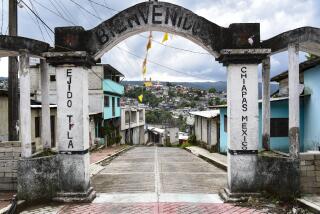Orphans of War in Ayacucho
- Share via
Peruvians like to tell stories to each other. That used to be the way they kept their traditions alive. They said the Indian word “Ayacucho” meant “death’s hideaway”.
But there were days, not too long ago, when Ayacucho was called the Emerald of the Andes. I remember playing hide and seek with my brother along narrow cobblestone streets, darting in and out of 400-year-old churches and plazas. That was when people told stories about ghosts and other mysterious inhabitants in the mountain gorges and in the realms of their imaginations. And that was before death left hundreds of children homeless and orphaned, innocent victims of the 1980s war against the state by the guerrillas of Sendero Luminoso, who silenced the chimes of Ayacucho’s 26 colonial churches that outline the sky in crosses.
Last month I returned home to Ayacucho to hear stories of personal suffering. Caught in a bloody cross fire between brutal Maoist guerrillas and repressive military campaigns, thousands of peasants have died. The fighting has also left hundreds of orphans at empty street corners and in cold mountain crevices. Sendero Luminoso-- Shining Path--grew out of a split in the Communist Party of Peru, led by a philosophy teacher at the University of San Cristobal de Huamanga, located in the city of Ayacucho. It attracted campesino union leaders and provided a dramatic outlet for their frustration and anger against the powerful men who controlled their destinies.
I also went home to visit the orphans of that war, the ones Pope John Paul II prayed for two years ago before leaving them a donation of $50,000. I was curious to see how those funds and the donations sent by Peruvians living in the United States were being used.
It was 7:30 a.m. when our jet landed on a plain 8,283 feet high in the Andes and taxied to a stop across from lines of armed soldiers. They were standing guard for the return flight that was to carry the bodies of two soldiers killed in an attack by the Shining Path. “There is nothing to fear,” said Msgr. Federico Richter Prada, spiritual leader of Ayacucho, who greeted us with his blessings. Several army officers escorted him and rushed us to a chauffeur-driven pickup truck.
We drove through empty streets that never used to be empty. In spite of its poverty, Ayacucho used to be one of the busiest Andean towns in Peru. And I thought of the impact of revolution, of what it had done to the native population, or what is left of it.
There are more than 1,000 war victims under age 20. No one in his right mind would dare a census in the Andes rural areas. No one knows who is a Senderista these days and no one trusts anybody.
But the stories are undisputed. During the years of intensive guerrilla attacks, 1983-85, the war left the children of Ayacucho on their own. Some were found hidden in the huts by the hills, where their parents had been assaulted and killed. Others were found next to the murdered and mutilated bodies of adults who were taking care of them. Everyone has a horror story to tell and document.
A social worker who serves three orphanages handed me a notebook on the luckier war orphans who were housed at homes supported with funds left by the Pope. Each child is a survivor of abandonment, cold and malnutrition.
The three homes housing a total of 76 children are in the towns of Huanta, Tambo and Huancapi--several hours drive from Ayacucho via narrow, dusty, bumpy roads that wind up and down the Andes. The houses are supervised by Catholic nuns. Each is a home for orphans found starving by soldiers or civilians. Ina, for instance, about 8, was found carrying her baby brother on her back. They had been subsisting on cracked cereal she carried on a filthy rag. Now, her teeth are rotten. Her brother clings to her skirt and avoids eye contact. In time they will be friendly, insisted Sister Clarisa, who lives with the children.
Victims like Ina are the reason John Paul II included Ayacucho in his Latin American itinerary, to pray that “all Peruvians turn their hearts to the suffering of their people.” In Lima, Anabella Jordan, wife of a former U.S. ambassador to Peru, plus Msgr. Richter and a contingent of volunteers organized an emergency fund. In Houston, Texas, Help Ayacucho-Peru was founded to find parents for the children.
In Tambo, 288 miles north of Ayacucho, three Franciscan nuns serve two meals a day to more than 100 orphaned children, who attend school during the day and stay with campesino friends at night. The building, home for eight resident orphans, is about to collapse. There is hardly any plaster covering the adobe wall and thatched ceilings.
On the way back to Ayacucho, armed soldiers stopped our truck twice for inspections. We also had to make a sudden stop to avoid a hand-made explosive.
The fact that now one can visit Ayacucho and venture to nearby towns does not mean the war is over. Some of the orphans, in fact, are the children of women who went off to become guerrillas while the majority are children of innocent parents who died without having fought for either side. The government of Alan Garcia is aware of the situation and is making efforts to restore the city. Political and economic reforms have begun. Resettlement of displaced peasants is already a fact.
When leaving Tambo, I saw a conglomeration of improvised tin-roofed houses, where campesinos live close together in case of a guerrilla attack. In Lima, the Pueblos Jovenes --new settlements--are populated by a large number of campesinos who fled from the terror of war.
The bloody confrontations between Sendero and the government have diminished recently. The government has agreed to invest more money in projects to benefit the Andean region but finds it difficult to keep professional personnel in the area because of continuing guerrilla activities, however less murderous.
Survival of Ayacucho’s children depends on the outcome of the resettlement of the areas, where villages have been destroyed because the inhabitants supported guerrillas--or because they didn’t--or because they did not vote in elections or because they refused to move to military control zones. Whatever the reason, the children were the losers. So if the sun, god of the Incas and the Peruvian symbol of freedom, is to shine again, the children need to be protected and educated--and told new stories of hope.
More to Read
Sign up for Essential California
The most important California stories and recommendations in your inbox every morning.
You may occasionally receive promotional content from the Los Angeles Times.










